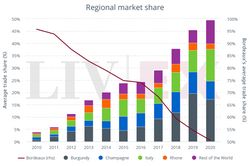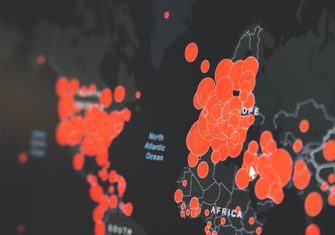
Fine wine’s investment performance is tracking as predicted – steady as a rock – whilst equities, bonds and other assets peak and trough the choppy seas of global financial markets, suffering the effects of Covid-19, a storm that is likely to prevail until, realistically, mass vaccines can be produced.
We are all looking for signs. How do we minimise risk and protect hard-earned capital against the effects of recession? Where are the opportunities to shelter wealth and grow returns?
The important factor to remember when portfolio planning is to ensure a diversified approach to manage risk and provide some certainty to overall performance. Fine wine’s stability and relative resistance to the forces currently at play is an important consideration.
In March 2020, the first Covid impact point on Europe and the US, the initial response by financial markets was to see falls in the FTSE 100 of over -15% and the S&P 500 fell -11.8%, whilst wine investment’s key index, the Liv-ex 100, matched gold, holding relatively steady at -1.1% In contrast during April 2020 we have seen the markets swing back, perhaps a result of some positive commentary on early drug trials in both the US and Europe. The FTSE has risen 6.9% in the month and the S&P500 is up 12.2%. Safe haven gold has also risen 6.9% and fine wine has, again, held steady at -0.3%.
Table 1: Fine wine v. Other Assets Performance 2020:
| Index | March 2020 | April 2020 | YTD |
| Liv-ex 50 | -2.2% | 0.8% | -3.3 |
| Liv-ex 100 | -1.1% | -0.3% | -1.4 |
| Liv-ex Bordeaux 500 | -1.8% | 0.1% | -2.7 |
| FTSE 100 | -15.2% | 6.9% | -20.9 |
| S&P 500 | -11.8% | 12.2% | -9.6 |
| Gold | -1.1% | 5.6% | 12.4 |
Source: Liv-ex.com, 30 April, 2020
Across the two months, the markets have seen enough action to break and, possibly, make fortunes – but we have got a long way to go. Throughout this period, packed with uncertainty, a proportion of capital should be held where there is some reliability or predictability in performance, even if that is simply holding value.
We should look for lessons where we can. The 2008 – 2009 financial crisis was the result of very different stimulus to Covid-19 and the fine wine market saw significant growth as Chinese buyers also entered the market. At this time, 90% of trade on Liv-ex was in the top Bordeaux brands and some of this was held by fine wine funds, reportedly accounting for more than €300million assets under management.
At the height of the financial crisis, Bordeaux responded smartly by offering its 2008 vintage at a discount to previous vintages and 2008 has delivered some of the best returns for investors. 2008 was also the vintage the Chinese market really arrived in volume for the first time. Fine wine weathered the 2008 financial crisis well. However, there was an after-shock, the result of a particular market dynamic that no longer applies in 2020 – the market was not diversified in 2009 but was Bordeaux-centric.

Post 2010, Chinese consumers, then restricted by new laws against ‘gift-giving’ responded to the supercharged price rises of their favourite Bordeaux First Growths, sought value in the wines of other regions. The heavily Bordeaux-weighted fine wine market saw an unprecedented decline as funds also exited where they could, desperate to liquidate assets post the financial crash.
During the fine wine market correction that ensued, the Liv-ex Bordeaux 500 index, which measures the latest ten physical vintages of the five Bordeaux First Growths, dropped 14%, however the ten vintages prior to that fell only 8% and the ten prior to that (1980’s wines), hardly fell at all. What do we take from this? Rare, older, fine wines are even more resistant to negative forces and you should also diversify a fine wine investment collection by vintage to maximise your tax-free gains.
Importantly, in 2020 the fine wine market is now truly diversified and continues to broaden across all regions with growing numbers of individual fine wines trading on Liv-ex month on month. Bordeaux now accounts for no more than average 50% of trade value on Liv-ex and in April 2020 the composition of Liv-ex trade share saw Bordeaux account for 41%, Italy 22.5%, Burgundy 9.3%, Champagne 8.7%, Rhone 5.2% and the Rest of the World – 13.3%.
This element of risk, i.e. lack of diversification, has been removed from the fine wine market and investors should ensure that their portfolios are similarly diversified by region and vintage to optimise growth opportunities and minimise risk.
The key messages are – fine wine’s stable asset performance offers an important tool for diversifying your portfolio to manage risk and protect wealth, especially during times of economic uncertainty and volatility. Talk to us now about how you can further enhance performance through strategic selection of fine wine and get more information on regional market trends and rare older vintages to optimise returns.
Call the Vin-X team on 0203 384 2262 and follow us on Facebook, Twitter and Instagram to get the latest news and opinions.

